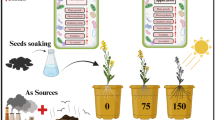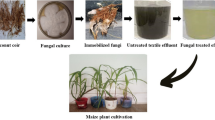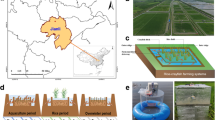Abstract
The programmed application of organic fertilizers represents one relevant way to decrease the cost of nitrogen fertilizer, minimizing environmental pollution. We designed the field experiments as a factorial in a randomized complete block design with 20 treatments and three replications at two locations in Iran (Tehran and West Azerbaijan province). The tested treatments were as follows: two genotypes (Landrace and SZK-1 cultivar); seed inoculation treatments (with and without bacterial inoculation), and five fertilization regimes (FR1: 100% urea (70 kg N ha−1), FR2: 75% urea (52.5 kg N ha−1) + 25% azocompost (3.85 t ha−1), FR3: 50% urea (35 kg N ha−1) + 50% azocompost (7.77 t ha−1), FR4: 25% urea (17.5 kg N ha−1) + 75% azocompost (11.55 ton ha−1) and FR5: 100% azocompost (15.55 ton ha−1). Application of azocompost enhanced total flavonoid content at a high level at Tehran and a medium level at Khoy. High doses of urea enhanced nitrogen accumulation in plants. The treatments with higher azocompost contents reflected the highest amounts of NPK. On the other hand, the Landrace cultivar evidenced higher chlorophyll concentration than the SZK-1 cultivar at Tehran. High doses of urea produced higher photosynthetic pigment in plants. Application of plant growth promoting regulation (at Tehran) and medium concentration of azocompost enhanced xylose concentration. In this context, the azocompost application improved mannose content. The essential oil yield in the Landrace cultivar was higher than that reflected by the SZK-1 cultivar. For both genotypes, results suggest that bacterial inoculation improves essential-oil production. Results showed that plant growth–promoting regulators and azocompost at medium and high levels improved most plant traits. Although the biological-based plant growth promoters exhibited positive effects in some experimental units, these effects were lower than that of a conventional fertilizer regime. Therefore, azocompost integrated with bacterial inoculation responded to be a suitable substitute for chemical fertilizer treatment.


Similar content being viewed by others
Data availability
The datasets used and/or analysed during the current study are available from the corresponding author on reasonable request.
References
Ahmadpour R, Armand N (2020) Effect of ecophysiological characteristics of tomato (Lycopersicon esculentum L.) in response to organic fertilizers (compost and vermicompost). Not Bot Horti Agrobot Cluj Napoca 48(3):1248–1259. https://doi.org/10.15835/nbha48311834
Anwar AlyTaie H, Abd-El Rahman Salama Z, Radwan S (2010) Potential activity of basil plants as a source of antioxidants and anticancer agents as affected by organic and bio-organic fertilization. Bot Hort Agrobot Cluj 38(1):119–127
AOAC (1990) Official methods of analysis. Association of Official Agricultural Chemists, Washington, DC, U.S.A
Arnon DI (1949) Copper enzymes in isolated chloroplasts. Polyphennol oxidase in Beta vulgaris. Plant Physiol 24(1):1–150. https://doi.org/10.1104/pp.24.1.1
Arrobas M, Ferreira IQ, Afonso S, Ângelo Rodrigues M (2018) Sufficiency ranges and crop nutrient removals for peppermint (Mentha × piperita L.) established from field and pot fertilizer experiments. Commun Soil Sci Plant Anal 49(14). https://doi.org/10.1080/00103624.2018.1474909
Asadu CO, Aneke NAG, Egbuna SO (2018a) Enrichment of the nutritional contents of sawdust by composting with other nitrogen rich agro-wastes for biofertilizer synthesis. J Chem Technol Metall 53(3):430–436
Asadu CO, Aneke NG, Egbuna SO, Agulanna AC (2018b) Comparative studies on the impact of bio-fertilizer produced from agro-wastes using thermo-tolerant actinomycetes on the growth performance of Maize (Zea mays) and Okro (Abelmoschus esculentus). Environ Technol Innov 12:55–71. https://doi.org/10.1016/j.eti.2018.07.005
Bagheri Novair S, Mirseyed-Hosseini H, Etesami H, Razavipour T (2020) Rice straw and composted azolla alter carbon and nitrogen mineralization and microbial activity of a paddy soil under drying–rewetting cycles. Applied Soil Ecology 154:103638. https://doi.org/10.1016/j.apsoil.2020.103638
Bernard S, Dinssa FF, Wu Q, Simon JE (2020) Elemental micronutrients, antioxidant activity, total polyphenol, and total flavonoid content of selected spider plant accessions (Cleome gynandra) grown in Eastern Africa and the Eastern United States. J Medicin Active Plant 9(3):157–165. https://doi.org/10.7275/jnrp-3y92
Berova M, Pevicharova G, Stoeva N, Zlatev Z, Karanatsidis G (2013) Vermicompost affects growth, nitrogen content, leaf gas exchange and productivity of pepper plants. J Elementology 4:565–576
Bouaroudj S, Menad A, Bounamous A, Ali-Khodja H, Gherib A, Weigel DE, Chenchouni H (2019) Assessment of water quality at the largest dam in Algeria (Beni Haroun Dam) and effects of irrigation on soil characteristics of agricultural lands. Chemosphere 219:76–88. https://doi.org/10.1016/j.chemosphere.2018.11.193
Boudjabi S, Chenchouni H (2021) On the sustainability of land applications of sewage sludge: how to apply the sewage biosolid in order to improve soil fertility and increase crop yield? Chemosphere 282:131122. https://doi.org/10.1016/j.chemosphere.2021.131122
Butar Butar RR, Sitepu FE, Hasanah Y (2018) Growth response of peppermint (Mentha piperita L.) stem cuttings on several composition of planting media. Indonesian. J Agric Res 1(2):187–192. https://doi.org/10.32734/injar.v1i2.312
Camen D, Dragomir D, Popescu C (2017) Study regarding the influence of fertilization on some physiological index and biochemical composition of peppermint oils (Mentha piperita L.). Rom Biotechnol Lett 54:356–369
Chenchouni H, Mekahlia MN, Beddiar A (2020) Effect of inoculation with native and commercial arbuscular mycorrhizal fungi on growth and mycorrhizal colonization of olive (Olea europaea L.). Sci Hortic 261:108969. https://doi.org/10.1016/j.scienta.2019.108969
Dahui L, Wei L, Duanwei Z, Mingjian G, Wenbing Z, Tewu Y (2010) Nitrogen effects on total flavonoids, chlorogenic acid, and antioxidant activity of the medicinal plant Chrysanthemum morifolium. J Plant Nutr Soil Sci 173:268–274. https://doi.org/10.1002/jpln.200900229
Dastmalchi K, Damien Dorman HJ, Laakso I, Hiltunen R (2007) Chemical composition and antioxidative activity of Moldavian balm (Dracocephalum moldavica L.) extracts. LWT 40:1655–1663. https://doi.org/10.1016/j.lwt.2006.11.013
Dekak A, Menasria T, Benhizia Y, Chenchouni H (2020) Endophytic passenger bacteria associated with Genista cinerea nodules growing in North African drylands. Rhizosphere 14:100205. https://doi.org/10.1016/j.rhisph.2020.100205
Del Amor FM, Cuadra-Crespo P, Var ob P, G'omezb MC (2008) Influence of foliar urea on the antioxidant response and fruit color of sweet pepper under limited N supply. J Sci Food Agric 89(3):504–510. https://doi.org/10.1002/jsfa.3485
Dmitruk M, Weryszko-Chmielewska S (2010) Morphological differentiation and distribution of non-glandular and glandular trichomes on Dracocephalum moldavicum L. shoots. Acta Agrobotanica 1:11–22. https://doi.org/10.5586/aa.2010.002
Dubois M, Gilles KA, Hamilton JK, Rebers PA, Smith F (1956) Colorimetric method for determination of sugars and related substances. Anal Chem 28:350–356. https://doi.org/10.1021/ac60111a017
Ebrahimi Sborezi H, Modarres-Sanavy S, Baghbani-Arani A (2021) Assessment of morpho-physiological and quantitative and qualitative yield of Peppermint (Mentha piperita L.) under different irrigation regimes and application of different nitrogen fertilizer. Envi Stress Crop Sci 14(2):425–437. https://doi.org/10.22077/escs.2019.2893.1744
Ebrahimian S, Pirzad A, Jalilian J, Rahimi A (2021) The effect of micronutrients supplementation (Fe, Zn, B, and Mn) on antioxidant activity of milk thistle (Silybum marianum L.) under rainfed condition. J Medicinal Plants by-product 10:43–50. https://doi.org/10.22092/jmpb.2021.123781
Egbuna SO, Asadu CO, Onoh MI (2016) Production of biofertilizer by composting sawdust, sewage sludge and succulent tissue of green plants using an accelerator. Int J Novel Res Eng Sci 3:62–72
Fernández-Zamudio R, García-Murilloa P, Cirujano S (2010) Germination characteristics and sporeling success of A. filiculoides Lam., an aquatic invasive fern, in a Mediterranean temporary wetland. Aquat Bot 93:89–92. https://doi.org/10.1016/j.aquabot.2010.03.011
Fiasconaro ML, Lovato ME, Antolín MC, Clementi LA, Torres N, Gervasio S, Martín CA (2019) Role of proline accumulation on fruit quality of pepper (Capsicum annuum L.) grown with a K-rich compost under drought conditions. Sci Hortic 249:280–288. https://doi.org/10.1016/j.scienta.2019.02.002
Gharib FA, Moussa LA, Massoud ON (2008) Effect of compost and bio-fertilizers on growth, yield and essential oil of sweet marjoram (Majorana hortensis) plant. Int J Agric Biol 10:381–387
Hosseini SJ, Tahmasebi-Sarvestani Z, Mokhtassi-Bidgoli A, Keshavarz H, Sh K, Khalvandi M, Pirdashti H, Hashemi-Petroudi SH, Nicola S (2023) Functional quality, antioxidant capacity and essential oil percentage in different mint species affected by salinity stress. Chem Biodivers:e202200247. https://doi.org/10.1002/cbdv.202200247
Hussein MS, El-Shrbeny SE, Khlil MY, Naguib NY, Aly SM (2006) Growth characters and chemical constituents of Dracocephalum moldavica L. plants in relation to compost fertilizer and planting distance. J Sci Horti 108:322–331. https://doi.org/10.1016/j.scienta.2006.01.035
Jackson L (1965) Soil chemical analysis, advanced course, Publ. by Author, Madison, Wisconsin, U.S.A
Jackson ML (1973) Soil chemical analysis. Prentice-Hall of India Private, Limited, New Delhi
Jahani F, Tohidi-Moghadam HR, Larijani HR, Ghooshchi F, Oveysi M (2021) Influence of zinc and salicylic acid foliar application on total chlorophyll, phenolic components, yield and essential oil composition of peppermint (Mentha piperita L.) under drought stress condition. Arab J Geosci 14:691. https://doi.org/10.1007/s12517-021-07024-3
Kashchenko NI, Jafarova GS, Isaev JI, Olennikov DN, Chirikova NK (2022) Caucasian Dragonheads: phenolic compounds, polysaccharides, and bioactivity of Dracocephalum austriacum and Dracocephalum botryoides. Plants 11:2126. https://doi.org/10.3390/plants11162126
Kawa-Miszczak L, Węgrzynowicz-Lesiak E, Gabryszewska E, Saniewski M (2009) Effect of different sucrose and nitrogen levels in the medium on chlorophyll and anthocyanin content in Clematis pitcheri shoots cultured in vitro at different temperatures. J Fruit Ornam Plant Res 17(1):113–121
Keshavarz H (2020) Study of water deficit conditions and beneficial microbes on the oil quality and agronomic traits of canola (Brassica napus L.). Grasas Y Aceites 71(3):e373. https://doi.org/10.3989/gya.0572191
Keshavarz H, Hosseini SJ, Sedibe MM, Achilonu MC (2021) Arbuscular mycorrhizal fungi used to support Iranian barley (Hordeum vulgare L.) cultivated on cadmium contaminated soils. Appl Ecology. Environ Res 20(1):43–53. https://doi.org/10.15666/aeer/2001_043053
Keshavarz H, Khodabin G (2019) The role of uniconazole in improving physiological and biochemical attributes of bean (Phaseolus vulgaris L.) subjected to drought stress. J Crop Sci Biotech 22(2):161–168. https://doi.org/10.1007/s12892-019-0050-0
Keshavarz H, Modarres Sanavy SAM, Sadegh Gol Moghadam R (2016) Impact of foliar application with salicylic acid on biochemical characters of canola plants under cold stress condition. Not Sci Biol 8(1):98–105. https://doi.org/10.15835/nsb.8.1.9766
Keshavarz H, Modarres-Sanavy SAM, Mahdipour Afra M (2018) Organic and chemical fertilizer affected yield and essential oil of two mint species. J Ess Oil Bear Plant 21(6):1674–1681. https://doi.org/10.1080/0972060X.2018.1497545
Keshavarz H, Sadegh Ghol Moghadam R (2017) Seed priming with cobalamin (vitamin B12) provides significant protection against salinity stress in the common bean. Rhizosphere 3:143–149. https://doi.org/10.1016/j.rhisph.2017.04.010
Keshavarz Mirzamohammadi H, Modarres-Sanavy SAM, Sefidkon F, Mokhtassi-Bidgoli A, Mirjalili MH (2021a) Irrigation and fertilizer treatments affecting rosmarinic acid accumulation, total phenolic content, antioxidant potential and correlation between them in peppermint (Mentha piperita L.). Irrigation Sci 39:671–683. https://doi.org/10.1007/s00271-021-00729-z
Keshavarz Mirzamohammadi H, Tohidi-Moghadam HR, Hosseini SJ (2021b) Is there any relationship between agronomic traits, soil properties and essential oil profile of peppermint (Mentha piperita L.) treated by fertiliser treatments and irrigation regimes? Ann Appl Biol 179(3):331–344. https://doi.org/10.1111/aab.12707
Keyvan Rad S, Madani H, Heidari Sharifabadi H, Mahmoudi M, Nourmohamadi G (2022) Effects of different irrigation intervals and sowing time on yield attributing traits of okra (Abelmoschus esculentus L.). Arab J Geosci 15:740. https://doi.org/10.1007/s12517-022-09663-6
Khalil SES, El-Noemani ASA (2015) Effect of bio-fertilizers on growth, yield, water relations, photosynthetic pigments and carbohydrates contents of Origanum vulgare L. plants grown under water stress conditions, American-Eurasian J Sustainable. Agri 9(4):60–73
Kolton A, Baran A (2008) Effect of different mineral nitrogen and compost nutrition on some compounds of corn salad (Valerianella locusta (L.) Latter.). Sodininkystė ir Daržininkystė 2008 27(2):379–387 https://www.cabdirect.org/cabdirect/abstract/20093155293
Kopsell DA, Kopsell DE, Curran-Celentano J (2007) Carotenoid pigments in kale are influenced by nitrogen concentration and form. J Sci Food Agric 87:900–907. https://doi.org/10.1002/jsfa.2807
Krizek DT, Kramer GF, Upadhyaya A, Mirecki RM (1993) UV-B Response of cucumber seedling grown under metal halid and high pressure sodium/deluxe lamps. Plant Physiol 88:350–358. https://doi.org/10.1111/j.1399-3054.1993.tb05509.x
Li J, Chang Y, AA AL-H, Ding Z, Al-Harbi MS, Ali EF, AHA A, Rekaby SA, Eissa MA, Ghoneim AM, Tammam SA (2021) Effect of manure and compost on the phytostabilization potential of heavy metals by the halophytic plant wavy-leaved saltbush. Plants 10(10):2176. https://doi.org/10.3390/plants10102176
Marashi M, Shafaghatian D, Mahboub Khomami A (2021) The impact of different levels of azocompost on growth medium chemical characteristics, growth and nutrition of zinnia elegans. J Orna Plant 11(2):123–134
Martínez-Blanco J, Antón A, Rieradevall J, Castellari M, Muñoz P (2011) Comparing nutritional value and yield as functional units in the environmental assessment of horticultural production with organic or mineral fertilization. Int J Life Cycle Assess 16(1):12–26. https://doi.org/10.1007/s11367-010-0238-6
Mehalaine S, Chenchouni H (2020) Plants of the same place do not have the same metabolic pace: soil properties affect differently essential oil yields of plants growing wild in semiarid Mediterranean lands. Arabian Journal of Geosciences 13(23):1263. https://doi.org/10.1007/s12517-020-06219-4
Mehalaine S, Chenchouni H (2021a) New insights for the production of medicinal plant materials: ex vitro and in vitro propagation of valuable Lamiaceae species from northern Africa. Current Plant Biology 27C:100216. https://doi.org/10.1016/j.cpb.2021.100216
Mehalaine S, Chenchouni H (2021b) Quantifying how climatic factors influence essential oil yield in wild-growing plants. Arabian Journal of Geosciences 14(13):1257. https://doi.org/10.1007/s12517-021-07582-6
Mehalaine S, Menasria T, Chenchouni H (2023) Screening of seed germination requirements of some native plants of the Mediterranean region. Scientia Horticulturae 312:111838. https://doi.org/10.1016/j.scienta.2023.111838
Miri M, Ghooshchi F, Tohidi-Moghadam HR, Larijani HR, Kasraie P (2022) Ameliorative effects of foliar spray of glycine betaine and gibberellic acid on cowpea (Vigna unguiculata L. Walp.) yield affected by drought stress. Arab J Geosci 14:830. https://doi.org/10.1007/s12517-021-07228-7
Rahimzadeh S, Sohrabi Y, Heydari GH, Pirzad AR (2011) Effect of biological fertilizers on performance and some morphological characteristics of Dragonhead (Dracocephalum moldavica L.). J Hort Science 25(3):335–343
Rah Khosravani AT, Mansourifar C, Modarres-Sanavy SAM, Asilan KS, Keshavarz H (2017) Effects of sowing date on physiological characteristics, yield and yield components for different maize (Zea mays L.) hybrids. Notulae Sci Bio 9(1):143–147. https://doi.org/10.15835/nsb919913
Raimi A, Roopnarain A, Adeleke R (2021) Biofertilizer production in Africa: current status, factors impeding adoption and strategies for success. Sci Afr 11:e00694. https://doi.org/10.1016/j.sciaf.2021.e00694
Sabourifard H, Estakhr A, Bagheri M, Hosseini SJ, Keshavarz H (2023) The quality and quantity response of maize (Zea mays L.) yield to planting date and fertilizers management. Food Chem Adv 2:100196. https://doi.org/10.1016/j.focha.2023.100196
Saikia LR, Upadhyaya S (2011) Antioxidant activity, phenol and flavonoid content of A. racemosus Willd. a medicinal plant grown using different organic manures. J Agric Food Chem 56:5788–5794
SAS Institute Inc (2002) The SAS System for Windows, Release 9.0. Statistical Analysis Systems. SAS Institute, Cary, NC, USA
Setiawati MR, Damayani M, Herdiyantoro D, Suryatmana P, Anggraini D, Khumairah FH (2018) The application dosage of Azolla pinnata in fresh and powder form as organic fertilizer on soil chemical properties, growth and yield of rice plant. AIP Conference Proceedings 1927:030017. https://doi.org/10.1063/1.5021210
Shiow YW, Chen CT, Sciarappa W, Wang CY, Camp MJ (2008) Fruit quality, antioxidant capacity, and flavonoid content of organically and conventionally grown blueberries. J Agric Food Chem 56:5788–5794. https://doi.org/10.1021/jf703775r
Sotiropoulou DE, Karamanos AJ (2010) Field studies of nitrogen application on growth and yield of Greek oregano (Origanum vulgare ssp. hirtum (Link) Ietswaart). Ind Crops Prod 32:450–457. https://doi.org/10.1016/j.indcrop.2010.06.014
Stoll A, Salvatierra-Martínez R, González M, Cisternas J, Rodriguez Á, Vega-Gálvez A, Bravo J (2021) Importance of crop phenological stages for the efficient use of PGPR inoculants. Sci Rep 11:19548. https://doi.org/10.1038/s41598-021-98914-9
Sun B, Gu L, Bao L, Zhang S, Wei Y, Bai B, Zhuang G, Zhuang X (2020) Application of biofertilizer containing Bacillus subtilis reduced the nitrogen loss in agricultural soil. Soil Biol Biochem 148:107911. https://doi.org/10.1016/j.soilbio.2020.107911
Vafadar-Yengeje L, Amini R, Dabbagh Mohammadi Nasab A (2019) Chemical compositions and yield of essential oil of Moldavian balm (Dracocephalum moldavica L.) in intercropping with faba bean (Vicia faba L.) under different fertilizers application. J Clean Prod 239:118033. https://doi.org/10.1016/j.jclepro.2019.118033
Acknowledgements
The authors thank Dr. Josh Schimel (University of California Santa Barbara, Santa Barbara, California, United States of America) and Dr. Enrique Troyo-Diéguez (Centro de Investigaciones Biológicas del Noroeste, SC, Instituto Politécnico Nacional 195, Playa Palo de Santa Rita Sur, C.P. 23096, La Paz, Baja California Sur, Mexico) for the critical reading and editing of the manuscript.
Author information
Authors and Affiliations
Contributions
Saeed Yousefzadeh: designed and performed the experiment. Hamed Keshavarz wrote the manuscript. Seyed Ali Mohammad Modares Sanavy: farm operator. All the authors have read and approved the final manuscript and agreed to the published version of the manuscript.
Corresponding author
Ethics declarations
Conflict of interest
The authors declare that they have no competing interests.
Additional information
Responsible Editor: Haroun Chenchouni
Rights and permissions
Springer Nature or its licensor (e.g. a society or other partner) holds exclusive rights to this article under a publishing agreement with the author(s) or other rightsholder(s); author self-archiving of the accepted manuscript version of this article is solely governed by the terms of such publishing agreement and applicable law.
About this article
Cite this article
Yousefzadeh, S., Keshavarz, H. & Modares-Sanavy, S.A.M. Effects of ecological agriculture approaches on dragonhead (Dracocephalum moldavica L.) productivity and oil yield. Arab J Geosci 16, 373 (2023). https://doi.org/10.1007/s12517-023-11461-7
Received:
Accepted:
Published:
DOI: https://doi.org/10.1007/s12517-023-11461-7




